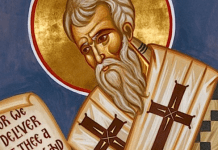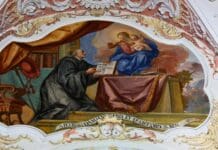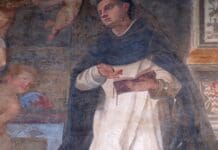Saint Hildegard of Bingen (1098-1179) Doctor of the Church was a remarkable woman, a “first” in many fields. At a time when few women wrote, Hildegard, known as “Sybil of the Rhine”, produced major works of theology and visionary writings. When few women were accorded respect, she was consulted by and advised bishops, popes, and kings.
Hildegard was born in 1098 at Bermersheim, Alzey, to parents of noble lineage who were wealthy landowners. At the age of eight she was received as an oblate at the Benedictine Abbey of Disibodenberg, where in 1115 she made her religious profession. Upon the death of Jutta of Sponheim, around the year 1136, Hildegard was called to succeed her as magistra. Infirm in physical health but vigorous in spirit, she committed herself totally to the renewal of religious life. At the basis of her spirituality was the Benedictine Rule which views spiritual balance and ascetical moderation as paths to holiness. Following the increase in vocations to the religious life, due above all to the high esteem in which Hildegard was held, around 1150 she founded a monastery on the hill of Rupertsberg, near Bingen, where she moved with twenty sisters. In 1165, she established another monastery on the opposite bank of the Rhine. She was the Abbess of both.
Within the walls of the cloister, she cared for the spiritual and material well-being of her sisters, fostering in a special way community life, culture and the liturgy. In the outside world she devoted herself actively to strengthening the Christian faith and reinforcing religious practice, opposing the heretical trends of the Cathars, promoting Church reform through her writings and preaching and contributing to the improvement of the discipline and life of clerics. At the invitation first of Hadrian IV and later of Alexander III, Hildegard practised a fruitful apostolate, something unusual for a woman at that time, making several journeys, not without hardship and difficulty, to preach even in public squares and in various cathedral churches, such as at Cologne, Trier, Liège, Mainz, Metz, Bamberg and Würzburg. The profound spirituality of her writings had a significant influence both on the faithful and on important figures of her time and brought about an incisive renewal of theology, liturgy, natural sciences and music. Stricken by illness in the summer of 1179, Hildegard died in the odour of sanctity, surrounded by her sisters at the monastery of Rupertsberg, Bingen, on 17 September 1179.
In her many writings Hildegard dedicated herself exclusively to explaining divine revelation and making God known in the clarity of his love. Hildegard’s teaching is considered eminent both for its depth, the correctness of its interpretation, and the originality of its views. The texts she produced are refreshing in their authentic “intellectual charity” and emphasize the power of penetration and comprehensiveness of her contemplation of the mystery of the Blessed Trinity, the Incarnation, the Church, humanity and nature as God’s creation, to be appreciated and respected.
These works were born from a deep mystical experience and propose a perceptive reflection on the mystery of God. The Lord endowed her with a series of visions from childhood, whose content she dictated to the Benedictine monk Volmar, her secretary and spiritual advisor, and to Richardis von Stade, one of her women religious. But particularly illuminating are the judgments expressed by Saint Bernard of Clairvaux, who encouraged her, and especially by Pope Eugene III, who in 1147 authorized her to write and to speak in public. Theological reflection enabled Hildegard to organize and understand, at least in part, the content of her visions. In addition to books on theology and mysticism, she also authored works on medicine and natural sciences. Her letters are also numerous — about four hundred are extant; these were addressed to simple people, to religious communities, popes, bishops and the civil authorities of her time. She was also a composer of sacred music. The corpus of her writings, for their quantity, quality and variety of interests, is unmatched by any other female author of the Middle Ages.
Her main writings are the Scivias, the Liber Vitae Meritorum and the Liber Divinorum Operum. They relate her visions and the task she received from the Lord to transcribe them. In the author’s view her Letters were no less important; they bear witness to the attention Hildegard paid to the events of her time, which she interpreted in the light of the mystery of God. In addition there are 58 sermons, addressed directly to her sisters.

















[…] uCatholic […]
To say that the Catholic Church is “anti-woman” is preposterous! To say that the Catholic Church is “behind the times” shows how uninformed an truly ignorant people are regarding the history and the Saints. What a treasure house we have in our magnificent Catholic Church!
Amen
[…] Source : ucatholic […]
[…] Source : ucatholic […]
[…] post Saint Hildegard of Bingen appeared first on […]
Saints have great visions for life.
St. Hildegard, pray for us.
Saint Hildegard of Bingen, pray for us!
St. Hildegard of Bingen, pls pray for us and the world